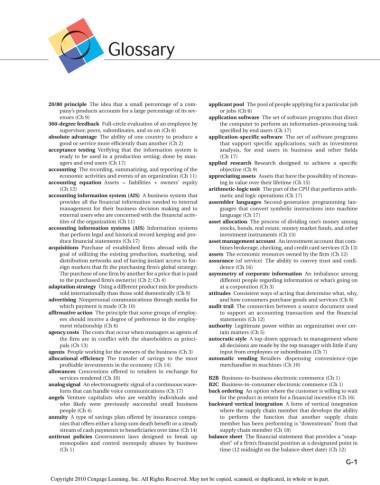Page 675 - Introduction to Business
P. 675
Glossary
20/80 principle The idea that a small percentage of a com- applicant pool The pool of people applying for a particular job
pany’s products accounts for a large percentage of its rev- or jobs (Ch 6)
enues (Ch 9) application software The set of software programs that direct
360-degree feedback Full-circle evaluation of an employee by the computer to perform an information-processing task
supervisor, peers, subordinates, and so on (Ch 6) specified by end users (Ch 17)
absolute advantage The ability of one country to produce a application-specific software The set of software programs
good or service more efficiently than another (Ch 2) that support specific applications, such as investment
acceptance testing Verifying that the information system is analysis, for end users in business and other fields
ready to be used in a production setting; done by man- (Ch 17)
agers and end users (Ch 17) applied research Research designed to achieve a specific
accounting The recording, summarizing, and reporting of the objective (Ch 9)
economic activities and events of an organization (Ch 11) appreciating assets Assets that have the possibility of increas-
accounting equation Assets = liabilities + owners’ equity ing in value over their lifetime (Ch 15)
(Ch 12) arithmetic-logic unit The part of the CPU that performs arith-
accounting information system (AIS) A business system that metic and logic operations (Ch 17)
provides all the financial information needed to internal assembler languages Second-generation programming lan-
management for their business decision making and to guages that convert symbolic instructions into machine
external users who are concerned with the financial activ- language (Ch 17)
ities of the organization (Ch 11) asset allocation The process of dividing one’s money among
accounting information systems (AIS) Information systems stocks, bonds, real estate, money market funds, and other
that perform legal and historical record keeping and pro- investment instruments (Ch 15)
duce financial statements (Ch 17) asset management account An investment account that com-
acquisitions Purchase of established firms abroad with the bines brokerage, checking, and credit card services (Ch 13)
goal of utilizing the existing production, marketing, and assets The economic resources owned by the firm (Ch 12)
distribution networks and of having instant access to for- assurance (of service) The ability to convey trust and confi-
eign markets that fit the purchasing firm’s global strategy; dence (Ch 16)
The purchase of one firm by another for a price that is paid asymmetry of corporate information An imbalance among
to the purchased firm’s owner(s) (Ch 2; Ch 4) different people regarding information or what’s going on
adaptation strategy Using a different product mix for products at a corporation (Ch 3)
sold internationally than those sold domestically (Ch 9) attitudes Consistent ways of acting that determine what, why,
advertising Nonpersonal communications through media for and how consumers purchase goods and services (Ch 8)
which payment is made (Ch 10) audit trail The connection between a source document used
affirmative action The principle that some groups of employ- to support an accounting transaction and the financial
ees should receive a degree of preference in the employ- statements (Ch 12)
ment relationship (Ch 6) authority Legitimate power within an organization over cer-
agency costs The costs that occur when managers as agents of tain matters (Ch 5)
the firm are in conflict with the shareholders as princi- autocratic style A top-down approach to management where
pals (Ch 13) all decisions are made by the top manager with little if any
agents People working for the owners of the business (Ch 3) input from employees or subordinates (Ch 7)
allocational efficiency The transfer of savings to the most automatic vending Retailers dispensing convenience-type
profitable investments in the economy (Ch 14) merchandise in machines (Ch 10)
allowances Concessions offered to retailers in exchange for
services rendered (Ch 10) B2B Business-to-business electronic commerce (Ch 1)
analog signal An electromagnetic signal of a continuous wave- B2C Business-to-consumer electronic commerce (Ch 1)
form that can handle voice communications (Ch 17) back ordering An option where the customer is willing to wait
angels Venture capitalists who are wealthy individuals and for the product in return for a financial incentive (Ch 16)
who likely were previously successful small business backward vertical integration A form of vertical integration
people (Ch 4) where the supply chain member that develops the ability
annuity A type of savings plan offered by insurance compa- to perform the function that another supply chain
nies that offers either a lump sum death benefit or a steady member has been performing is “downstream” from that
stream of cash payments to beneficiaries over time (Ch 14) supply chain member (Ch 18)
antitrust policies Government laws designed to break up balance sheet The financial statement that provides a “snap-
monopolies and control monopoly abuses by business shot” of a firm’s financial position at a designated point in
(Ch 1) time (12 midnight on the balance sheet date) (Ch 12)
G-1
Copyright 2010 Cengage Learning, Inc. All Rights Reserved. May not be copied, scanned, or duplicated, in whole or in part.

